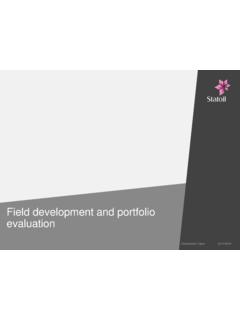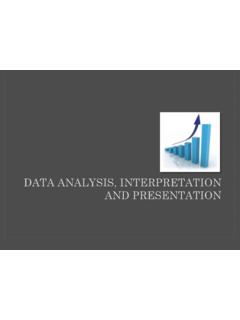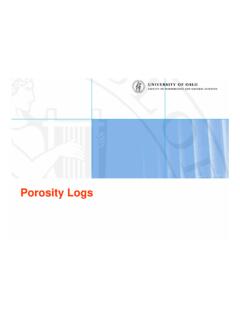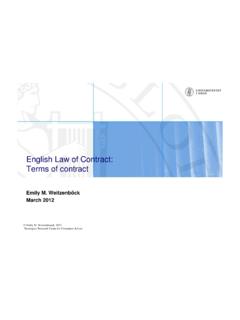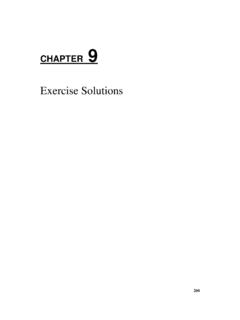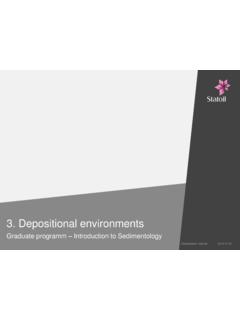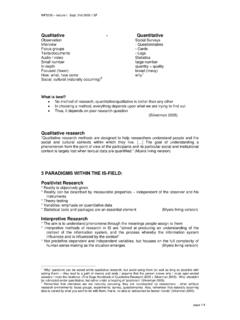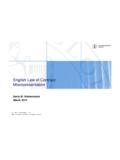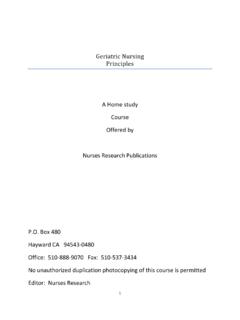Transcription of OPEN HOLE WIRELINE LOGGING Self Learning Module - UiO
1 OPEN HOLE WIRELINE LOGGING . Self Learning Module This document is part of a self Learning programme designed for new petroleum engineers with limited experience of LOGGING operations. Experienced engineers not directly involved with LOGGING operations but who would like to learn more about the subject may also find the Module useful. The Module contains an example of the Brent sands from the Northern North Sea and a step by step guide for how to approach the planning, supervision, interpretation and reporting of a LOGGING job. The document is intended to double as a quick reference guide for wellsite or office based staff who have followed the WIRELINE LOGGING self Learning programme. OPEN HOLE WIRELINE LOGGING .
2 CONTENTS. Section 1 Planning a LOGGING Job Section 2 Witnessing Operations Section 3 Quicklook Evaluation Hydrocarbon Saturation using the Archie Equation Wellsite Evaluation Section 4 Equipment Session Section 5 Exercises Module Section 6 Competency Assessment (Mentor Guidelines). TRACS INTERNATIONAL. OPEN HOLE WIRELINE LOGGING . 1. PLANNING A LOGGING JOB. Introduction Electric logs represent a major source of data to geoscientists and engineers investigating subsurface rock formations. LOGGING tools are used to look for reservoir quality rock, hydrocarbons and source rocks in exploration wells, support volumetric estimates and geological modelling during field appraisal and development, and provide a means of monitoring the distribution of remaining hydrocarbons during production life time.
3 A large investment is made by oil and gas companies in acquiring open hole log data, LOGGING activities can represent between 5% and 15% of total well costs. It is important therefore to ensure that the cost of acquisition can be justified by the value of information generated and that thereafter the information is effectively managed. To this end a number of questions need to be asked before commencing LOGGING operations, these include: 1. What is the objective of the data acquisition? 2. What type of LOGGING programme is appropriate? 3. How must the data acquisition be managed? 4. In what form should the data be presented? To answer such questions it is necessary to assess the consequence of prevailing geophysical uncertainty, be aware of both the principles of measurement and operational limitations of the LOGGING tools available, and understand how the LOGGING results will be used.
4 This document is intended to provide the reader with guidelines for planning a LOGGING job, witnessing LOGGING operations and the basic evaluation skills needed to address some of the more common North Sea data gathering objectives. It is also designed to serve as a handy wellsite reference for open hole LOGGING activities. Further details of both tool theory and evaluation techniques can be found in the Western Atlas WIRELINE Log Analysis manual or the Schlumberger Log Interpretation Principles / Applications manual, both of which are widely available within most petroleum engineering offices. TRACS INTERNATIONAL 1-1 Planning a LOGGING Job OPEN HOLE WIRELINE LOGGING . LOGGING objectives and programmes Wells can be broadly divided into two groups in terms of how LOGGING operations should be prioritised; information wells and development wells.
5 Exploration and appraisal wells are drilled for information and failure to acquire log data will compromise well objectives. Development wells are drilled primarily as production or injection conduits and whilst information gathering is an important secondary objective it should normally remain subordinate to well integrity considerations. In practical terms this means that LOGGING operations will be curtailed in development wells when hole conditions begin to deteriorate. This need not rule out further data acquisition as LOGGING through casing options still exist. In exploration wells where existing information is very limited LOGGING programmes will be rather extensive. Typical objectives might include: - detection of shallow hydrocarbons (rig safety issue).
6 - assessment of mechanical rock properties (for well design). - hole volume and shape estimates - stratigraphy and lithology identification - supporting information for structural interpretations - identification of depositional environments - assessment of source rock potential - measurement of acoustic properties (for time/depth relationships). - samples for lithology, hydrocarbon identification and rock dating - identification of potential reservoir intervals - location of hydrocarbon bearing reservoirs - reservoir quality and capacity assessment - estimation of reservoir deliverability - determination of pressure regime The acquisition of data to fulfill all of the objectives above would require an extensive LOGGING programme containing the tools such as those listed below (many of which can be run in combination).
7 Each LOGGING contractor has their own version of the these tools and in most cases equipment is identified by three letter abbreviations. Examples of the two main contractors Schlumberger and Western Atlas are shown overleaf. TRACS INTERNATIONAL 1-2 Planning a LOGGING Job OPEN HOLE WIRELINE LOGGING . Tool Types Schlum. W. Atlas Induction and/or Resistivity devices DIL/DLL DIFL/DLL. Micro resistivity MSFL ML. Litho-density and Neutron porosity LDT/CNL CDL/CNL. Acoustic LSS ACL. Caliper CAL CAL. Natural gamma GR GR. Spontaneous potential SP SP. Dipmeter (not covered in this document) SHDT HRDIP. Pressure testing devices RFT FMT. Rock and fluid sampling devices CST SWC. This sort of LOGGING programme could be achieved in 4 or 5 runs over each open hole section, and examples of how this would appear on a well programme are shown below: Western Atlas Schlumberger DIFL/ACL/CDL/CNL/GR/CAL DIL/LSS/LDT/CNL/GR.
8 DLL/ML/GR/SP DLL/MSFL/GR/SP. HRDIP SHDT. FMT (+ samples) RFT (+ samples). SWC (3 runs) CST (2 runs). NOTE: Details of these tools and applications can be found in the next section. In appraisal and development wells many of the information objectives listed earlier may no longer apply and LOGGING programmes will be reduced accordingly. In North Sea development wells where the reservoir is well understood LOGGING programmes will typically reduce to 2. runs; a combined tool string to assess reservoir thickness, porosity and hydrocarbon saturation, and a second run to acquire pressure (and connectivity) information. LOGGING in intervals other than the reservoir may be dropped completely. TRACS INTERNATIONAL 1-3 Planning a LOGGING Job OPEN HOLE WIRELINE LOGGING .
9 2. WITNESSING OPERATIONS. In this section the principles of measurement, limitations and operational considerations of the most common open hole LOGGING tools are described. To highlight the treatment of typical local issues, reference is made in each case to a log example from the Brent Sands in the North Sea. The individual log examples are presented together on the next page in a panel format similar to that which could be supplied to you on the wellsite by a LOGGING engineer (though the scale is rather compressed compared to reality). Pressure measurements are also included along side the logs. Using these logs and the information supplied in the rest of this section make an evaluation with the following objectives: - Identify all potential reservoir intervals and for each reservoir interval - Determine the fluid type - Calculate the average porosity - Calculate the average hydrocarbon saturation - Lastly explain the pressure profile over the sequence NOTE: The results are presented in the next section but you will get more value out of the example if you try it first without referring to the solution.
10 TRACS INTERNATIONAL 2-1 Witnessing Operations OPEN HOLE WIRELINE LOGGING . Well : NNS-08. INTERVALS PRESS. PSIA. CALIPER SPHER FOCUSED. 6 ( IN ) 16 1 ohmm 100. SONIC NEUTRON 140 s / ft ). ( 40 54 -6 1 ohmm 100. GR DENSITY 0 ( API ) 150 g / cc 1 ohmm 100. HEATHER 13600. 13650. 13700. 2923. 2930. 13750. MNS. 2626. 13800. 2632. ETIVE. 2636. 2641. 13850. 2656. 13900. RANNOCH. 2656. 13950. 3286. BROOM TIGHT. 3289. 14000. DUNLIN. 14050. 14100. TRACS INTERNATIONAL 2-2 Witnessing Operations OPEN HOLE WIRELINE LOGGING . Suggested procedure: 1. Read through the remainder of this section a find out how to process each log. Each log from the composite panel (previous page) is described seperately. 2. Working on the log panel use a combination of lithology and permeability indicators to identify the potential reservoir intervals.
